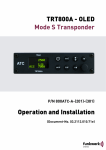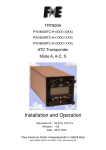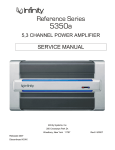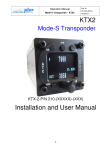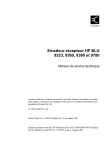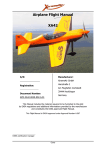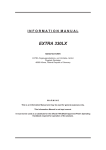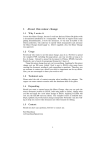Download Aiwa AD-F 800H Technical data
Transcript
TRT800H - OLED Mode S Transponder P/N 800ATC-H-(2xx)-(2xx) Operation and Installation (Document-No. 03.2124.010.71e) TRT800H / P/N 800ATC-H-(2xx)-(2xx) Operation and Installation Change History Revision Date Description of Change 1.00 18.11.2011 First Release 1.01 01.11.2012 Extended functions remote control interface and altitude compensation starting from software version 5.3 1.02 23.11.2012 Added information for TSO certification List of Service-Bulletins (SB) Service Bulletins have to be inserted into this manual and to be enlisted in the following table. SB No Rev. No. Insertion Issue Date Date SB TRT800-A-H-1 1.04 17.10.2008 Name Survey of Variants Part Number Description P/N 800ATC-H-(201)–(210) Version with OLED-Display / one VFRCode / eight storable record sets for AA-/AC-Code (ICAO 24bit-Address), FID, Ground-Switch, RI-Code, GPS/Interface-Setting, Auto-On-Function Version with OLED-Display / one VFRCode / eight storable record sets for AA-/AC-Code (ICAO 24bit-Address), FID, Ground-Switch, RI-Code, GPS/Interface-Setting, Auto-On-Function, remote control unit interface P/N 800ATC-H-(210)–(210) Document-No: 03.2124.010.71e / Revision: 1.02 2 TRT800H / P/N 800ATC-H-(2xx)-(2xx) Operation and Installation Table of Contents 1 2 3 3 GENERAL ..........................................................................................5 1.1 Symbols ...................................................................................5 1.2 Abbreviations ...........................................................................6 1.3 Customer Support ....................................................................6 1.4 Features ...................................................................................7 1.5 Deviations and Important Notes ...............................................8 OPERATION ......................................................................................9 2.1 Controls....................................................................................9 2.2 Switch ON/OFF ......................................................................11 2.3 Display - Indications ...............................................................12 2.4 Display-Brightness .................................................................13 2.5 Flight-ID (FID) ........................................................................13 2.5.1 Display Flight-ID ..........................................................13 2.5.2 Configure Flight-ID ......................................................14 2.6 Transponder Mode selection..................................................14 2.7 Squawk-Setting ......................................................................15 2.8 VFR – Squawk .......................................................................15 2.9 ID – Special Position Identification (SPI): “Squawk Ident”......16 2.10 Error-Codes............................................................................16 INSTALLATION................................................................................17 3.1 Notes......................................................................................17 3.2 Telecommunication data ........................................................17 3.3 Scope of Delivery ...................................................................17 3.4 Unpacking and Inspecting of the Equipment..........................18 3.5 Mounting ................................................................................18 3.6 Equipment Connections .........................................................19 3.6.1 Electrical Connections .................................................19 3.6.2 Static Air Port ..............................................................20 3.7 Wiring .....................................................................................20 3.7.1 Conductor Cross Section.............................................20 3.7.2 Pin Assignment ...........................................................21 3.7.3 TRT800EMRS – External Memory ..............................22 3.8 Antenna..................................................................................23 Document-No: 03.2124.010.71e / Revision: 1.02 TRT800H / P/N 800ATC-H-(2xx)-(2xx) Operation and Installation 4 5 3.8.1 Antenna Selection .......................................................23 3.8.2 Installation Recommendation ......................................23 3.8.3 Antenna Wiring ............................................................23 3.9 Post-Installation Check ..........................................................24 3.10 Starting Up .............................................................................25 3.11 Accessories............................................................................25 3.12 Drawings ................................................................................26 3.12.1 Dimensions..................................................................26 3.12.2 Mounting Advices ........................................................26 Transponder SETTINGS..................................................................27 4.1 Overview ................................................................................27 4.2 Display Configuration Summary.............................................27 4.3 General settings .....................................................................29 4.3.1 ICAO 24-Bit Aircraft Address (AA)...............................29 4.3.2 Aircraft Category (AC) .................................................29 4.3.3 Flight-ID (FID)..............................................................30 4.3.4 Reply Information - Speed Category (RI) ....................30 4.4 Optional settings ....................................................................31 4.4.1 Option Ground-Switch .................................................31 4.4.2 Option Remote Header................................................31 4.4.3 Serial Interface (RS232) ..............................................32 4.4.4 Altitude Correction/Offset ............................................33 4.5 Setup Procedure ....................................................................34 4.5.1 Setup Menu Control ....................................................34 4.5.2 Transponder configuration/record structure ................35 4.5.3 Transponder configuration/record handling.................35 4.5.4 General Setup .............................................................36 4.5.5 Altitude Correction Setup.............................................39 APPENDIX .......................................................................................41 5.1 Technical Data .......................................................................41 5.2 Environmental Conditions ......................................................43 5.3 DO-178B Open Problem Reports ..........................................44 Document-No: 03.2124.010.71e / Revision: 1.02 4 TRT800H / P/N 800ATC-H-(2xx)-(2xx) Operation and Installation 1 GENERAL This manual contains information about the physical, mechanical and electrical characteristics and about installation and operation of the Mode S Transponder TRT800H. The conditions and tests required for TSO approval of this article are minimum performance standards. Those installing this article either on or within a specific type or class of aircraft must determine that the aircraft installation conditions are within the TSO standards which include any accepted integrated non-TSO function standards. TSO articles and any accepted integrated non-TSO function(s) must have separate approval for installation in an aircraft. The article may be installed only according to 14 CFR part 43 or the applicable airworthiness requirements. This is an incomplete system (antenna is required) intended to provide the TSO functions specified in this Operation and Installation Manual, section 5.1. 1.1 Symbols Advices whose non-observance can cause radiation damage to the human body or ignition of combustible materials Advices whose non-observance can cause damage to the device or other parts of the equipment. Supplementary information 5 Document-No: 03.2124.010.71e / Revision: 1.02 TRT800H / P/N 800ATC-H-(2xx)-(2xx) Operation and Installation 1.2 Abbreviations Abb. Meaning Explanation FID Flight ID Flight plan number or if not assigned registration number of aircraft SPI Special Position Identification Activation on request by controllers „Squawk Ident“, transmits SPI Pulse for 18 seconds, which highlights the respective traffic item on the controllers radar screen AA Aircraft Address assigned ICAO 24 bit Address AC Aircraft Category Defines aircraft type into specific categories RI Reply Information Maximum airspeed 1.3 Customer Support In order to facilitate a rapid handling of return shipments, please follow the instructions of the input guide „Reshipment RMA“ provided at the Service-Area within the Funkwerk Avionics web portal www.funkwerkavionics.com. Any suggestions for improvement of our manuals are welcome. Contact: [email protected]. Information on software updates is available at Funkwerk Avionics Document-No: 03.2124.010.71e / Revision: 1.02 6 TRT800H / P/N 800ATC-H-(2xx)-(2xx) Operation and Installation 1.4 Features In order to operate the Mode-S transponder it is necessary to request an ICAO 24-Bit Aircraft Address at the responsible national aviation authorities. The received Code is assigned to the specific transponder/aircraft and must be configured within the transponder. The 24bit Address is stored in an external memory which allows the transponder being exchanged without requiring any further configuration. (for detailed information refer to sections 4.3.1 and 4.5.4). • Class 1 Level 2es Non-Diversity Mode-S-Transponder for ground based interrogations at 1030 MHz and response at 1090 MHz • Replies to (Secondary) Radar Interrogations o Mode-A replies with a Squawk (one of 4096 possible Codes; e.g. flight plan number, Squawk assigned by a Controller or the VFR Squawk 7000) o Mode C replies, including encoded flight level o Mode S replies, including aircraft address and flight level o Extended Squitter, containing additional information on position and velocity • IDENT capability for activating the Special Position Identification“Pulse (SPI) for 18 seconds, which is requested by the Controller „Squawk Ident“ • Maximum flight level 35 000 ft; maximum airspeed 250 kt • Display information contains Squawk code, mode of operation and pressure altitude. • Temperature compensated high precision piezo-resistive pressure sensor • RS-232 I/O data port enabling connection with certain GPSReceivers in order to support ADS-B Out • 8 storable entries for AA-/AC-Code, FID, Ground-Switch, RI-Code and GPS-/Interface-setting (stored in external memory TRT800EMxx) • Remote control unit interface 7 Document-No: 03.2124.010.71e / Revision: 1.02 TRT800H / P/N 800ATC-H-(2xx)-(2xx) Operation and Installation 1.5 Deviations and Important Notes The following deviations have been granted by the FAA: The device is certified to FAA TSO-C112c in lieu of FAA TSO-C112d. Environmental Qualification Testing was performed according to RTCA/DO-160D in lieu of RTCA/DO-160F. The Software of this device was developed according to RTCA DO-178B Design Assurance Level "D". The ADS-B function of this device has not been evaluated during the FAA TSO certification process other than to ensure non-interference. Due to the SW assurance of DAL "D", the ADS-B function cannot be used in the US National Airspace. The device must thus not be connected to a GPS source in the US National Airspace. This device contains an altitude measuring device that has not been evaluated during the FAA TSO certification process other than to ensure non-interference. This feature must be evaluated for intended function during FAA installation approval. Compliance to RTCA DO-181D was verified by testing against EUROCAE ED-73C. The two standards are technically identical with regard to the TRT800H. Document-No: 03.2124.010.71e / Revision: 1.02 8 TRT800H / P/N 800ATC-H-(2xx)-(2xx) Operation and Installation 2 OPERATION 2.1 Controls Activate/ deactivate VFR ON / OFF „Squawk Ident“ Active Squawk active Operation Mode Standby Squawk standby Select Operation Mode Cursor adjustment Change Active Ù Standby Squawk 9 Rotary Knob for adjusting values at the cursor position Document-No: 03.2124.010.71e / Revision: 1.02 TRT800H / P/N 800ATC-H-(2xx)-(2xx) Operation and Installation I/O VFR ON/OFF VFR ► Switch ON press button for approx. 0,5 s ► Switch OFFpress button for approx. 3 s ► activate/deactivate VFR Squawk (press shortly) ► store active Squawk as VFR/VFRW-Squawk (press button 3 s, →2.8) ► change between active and standby-Squawk ▲▼ CHANGE ► works as cursor back button (opposite function of the cursor button) during entering values and also for navigating backwards through the configuration menu (→4.5.4) ► „Squawk Ident“, sends Ident marking (SPI) for 18 s (→ 2.9) ID IDENT MODE MODE ► CURSOR Rotary Knob ► Enter Flight-ID (FID) setup (in standby mode, press button for approx. 5s) ► Select transponder operational mode (→ 2.6) ► Set position of Cursor ► Adjust/Enter values at current cursor position, select options; set standby Squawk (→ 2.7) Document-No: 03.2124.010.71e / Revision: 1.02 10 TRT800H / P/N 800ATC-H-(2xx)-(2xx) Operation and Installation 2.2 Switch ON/OFF Switch ON: press Switch OFF: press I/O for 0.5 s I/O for 3 s 2.2.1 Display information after power up After turning-on the display appears as follows (example): TRT800H. V5.3 Device Name FPGA-Vers: 102 Firmware Version 24D5F2 < BE2343 D4B3AA 000000 Software Version 000000 000000 000000 000000 If more than one configuration record is programmed the record selection menu appears (example). Select the desired record (rotary switch) and confirm with MODE. If no external memory is connected or no 24bit address is defined the message “CRADLE OFF” appears. In this case the device is working as “Mode AC only” transponder. Cradle OFF 2000 FL 030 STBY 11 7000 The transponder starts in STBY mode Document-No: 03.2124.010.71e / Revision: 1.02 TRT800H / P/N 800ATC-H-(2xx)-(2xx) Operation and Installation 2.3 Display - Indications Operational Mode: Active Lock out indication ACS Reply indication 7000 TM PLL/TRX/ DC SPI indicator | Test mode indicatior BAT/DIM Backlight setup IDT FL 030 Low battery ind. STBY 2000 Operational Mode: Standby Value Active Squawk Error indications Meaning 7000 active Squawk 2000 Standby Squawk FL 030 Flight Level FLerr Invalid altitude measuring Passive Squawk F Flight level GND switch status Remarks Could be changed with active Squawk by pressing ▲▼ Flight Level (in 100 ft steps) Beyond -1000 ... 35 000 ft, C Mode gets inactive ACS Operational Mode (STBY, A-S, ACS, AC, A) Modes see section 2.6 IDT transmits Ident-Marking (SPI) ID („Squawk Ident“) has been pressed – active for 18 s Transponder replies on Mode-S, Mode-A or ModeC interrogations No indication on ADSB and squitter transmission | Transponder is locked by a ground station and will be directly addressed Lock Information (indicated below the diamond) F G in-flight on-ground Ground-Switch-Info (if installed/available) Document-No: 03.2124.010.71e / Revision: 1.02 12 TRT800H / P/N 800ATC-H-(2xx)-(2xx) Operation and Installation Value Meaning Remarks Error indicators PLL PLL Error Internal Error TRX Transmit Failure Check antenna and wiring DC Low internal voltage Internal error FPG FPGA-Failure Internal error BAT Battery Power too low maybe battery/generator fault 2.4 Display-Brightness In active mode (not standby) press ► for 2 s Display indicates “DIM” Æ Adjust brightness (DIM) with rotary knob Return to normal operation: press 2.5 ► or wait 5 s. Flight-ID (FID) The FID is an identifier required by Mode-S Operation. During future application of flight plans a FID could be assigned on a per flight basis. If no FID is assigned (today’s normal case) the registration marking of the aircraft should be used as FID. The FID should not contain dashes or blanks. The FID must not be confused with the 24-bit Aircraft Address. 2.5.1 Display Flight-ID Press MODE (repeatedly) until „STBY“ appears Press and hold ID while a counter is shown beside the active squawk. During a few seconds Flight Identification is displayed FID 02 ABCDEFGH 13 Document-No: 03.2124.010.71e / Revision: 1.02 TRT800H / P/N 800ATC-H-(2xx)-(2xx) Operation and Installation 2.5.2 Configure Flight-ID Press MODE (repeatedly) until „STBY“ appears Press and hold ID while a counter is shown beside the active squawk. Release ID when “CHANGE FID” is displayed CHANGE FID __ ______ ABCDEFGH exit Enter Flight-Id with cursor button ► and rotary knob Enter FID left-aligned, without any blanks or dashes (!), e.g. 12345621DEFAV for the marking D-EFAV. The last remaining digits shall be filled with blanks Press MODE to save and return to STBY Please refer to section 4.5.4 for configuration of the 24-bit Address (AA) and Aircraft Category (AC). 2.6 Transponder Mode selection Press MODE (repeatedly) to select from following Modes: • STBY Æ „Standby“ Transponder does not respond to any interrogation. Squitter and ADS-B output is not active. • ACS Æ„Mode A+C+S“ Standard condition; transponder responds to mode A, C and S interrogations. • A-S Æ „Mode A+S, no C“ Altitude is not transmitted (neither on C nor on S requests). All other Mode-S data as well as Mode-A replies are transmitted. Document-No: 03.2124.010.71e / Revision: 1.02 14 TRT800H / P/N 800ATC-H-(2xx)-(2xx) Operation and Installation If no 24-bit address (AA) was defined or entered as “000000“ the transponder works as Mode A-C transponder, in that case the following Modes are possible apart from Standby: • AC- Æ „Mode A+C“ Transponder replies only on Mode A and Mode-C interrogations. • A-- Æ „Mode A“ Transponder replies only on Mode A interrogations. In STBY (Standby) mode, all transponder transmissions are disabled completely! Therefore, the transponder is not visible in this mode to air traffic control or the anti-collision systems onboard other aircrafts. Never use the STBY mode in flight unless you are requested to do so by air traffic control. Always remember to put the transponder in active mode prior to take off! 2.7 Squawk-Setting The active Squawk is displayed in the upper line, while the standby Squawk is presented at the lower line. Setting the Standby Squawk: • Press ► to set the cursor („^“), turn rotary knob to set numbers of the standby Squawk. • Press ▼▲ to activate the Standby Squawk (this moves the current active Squawk into Standby) 2.8 VFR – Squawk The transponder features a user-defined squawk code for VFR-flight (factory setting: 7000): • Activate VFR-Squawk: VFR („VFR“ is indicated), now the active Squawk is Press moved into Standby but not visible because the indication of the Standby Squawk is overlapped by „VFR“ 15 Document-No: 03.2124.010.71e / Revision: 1.02 TRT800H / P/N 800ATC-H-(2xx)-(2xx) Operation and Installation • Display Standby Squawk: Press VFR or ▼▲ or use the Squawk remains active!) rotary knob (the VFR- Example: STBY 4700 7000 7000 FL 030 FL 030 FL 030 5600 STBY VFR VFR STBY 4700 VFR • Now the Standby Squawk can be adjusted by using the knob and activated with ▼▲. rotary • In order to store the current active Squawk as new VFR-Squawk (replacing the factory setting 7000): Press and hold VFR until an „S“ is indicated (approx. 3 s); after releasing the button „VFR“ is shown 2.9 ID – Special Position Identification (SPI): “Squawk Ident” Press ID to activate transmission of the special position identification pulse with every reply within 18 seconds; “IDT” appears on the display By pressing ID a special position identification pulse (SPI) is transmitted with every reply within 18 seconds, which causes an accented marking on the Controller’s screen. The „Special Position Identification“ has to be activated after the „Squawk Ident“ request of the Controller. 2.10 Error-Codes Please refer to 2.3 Display - Indications for possible displayed errors. Document-No: 03.2124.010.71e / Revision: 1.02 16 TRT800H / P/N 800ATC-H-(2xx)-(2xx) Operation and Installation 3 INSTALLATION 3.1 Notes The following suggestions should be considered before installing. The assigned installation company will supply wiring. For diagrams refer to 3.7 Wiring. Transponder, External Memory, all cables and antennas shall be installed according to „FAA AC-143.13-2A Acceptable Methods, Techniques and Practices – Aircraft Alterations“ and the appropriate manufacturer’s instructions. 3.2 Telecommunication data Depending on your national telecommunications legislation, the following data may be required when applying for the aircraft radio station license: Manufacturer: Funkwerk Avionics GmbH Type Designation: TRT800H EASA Number: EASA.21O.269 Transmitter Power Output 126 W Frequency: 1090 MHz Emission Designator: 12M0M1D 3.3 Scope of Delivery Item name/number Description TRT800H Transponder TRT800H TRT800EMRS External Memory (Aircraft-Address-Adaptor with wiring) M4X8ZSW (3 pieces) screw for panels up to 5 mm thickness 56S101A4 TNC antenna connector 03.2124.010.71e Manual „Operation and Installation“ EASA Form 1 17 Document-No: 03.2124.010.71e / Revision: 1.02 TRT800H / P/N 800ATC-H-(2xx)-(2xx) Operation and Installation 3.4 Unpacking and Inspecting of the Equipment Carefully unpack the equipment and inspect for transport damages. If a damage claim has to be filed, save the shipping container and all packing materials as evidence to your claim. For storage or reshipment the original packaging should be used. 3.5 Mounting • In cooperation with a maintenance shop, location and kind of the installation are specified. The maintenance shop can supply all cables. Suitable sets of cables are available from Funkwerk Avionics GmbH. • Select a position away from heat sources. Care for adequate convection cooling. • Leave sufficient space for the installation of cables and connectors. • Avoid sharp bends and wiring close to control cables. • Leave sufficient lead length for inspection or repair of the wiring of the connector (containing the memory), so that when the mounting hardware for the rear connectors is removed, the assembly may be pulled forward several inches. • Bend the harness at the rear connectors to inhibit water droplets (formed due to condensation) from collecting in the connector. • For mounting details/drawing refer to chapter 3.12.2 Mounting Advices. Document-No: 03.2124.010.71e / Revision: 1.02 18 TRT800H / P/N 800ATC-H-(2xx)-(2xx) Operation and Installation 3.6 Equipment Connections 3.6.1 Electrical Connections One 15 pin D-SUB miniature connector includes all electrical connections, except for the antenna. Use only an External Memory Adapter TRT800EMxx as they are part of the certification and include a memory with the stored ICAO 24bit Aircraft Address. The (+UB)-wire has to protected by circuit breaker (2 Amp.)! 3.6.1.1 Mutual Suppression Other equipment on board (e. g. DME) may transmit in the same frequency band as the transponder. If such a device is installed a suppression wiring shall be installed in order to protect the receiving parts of the different devices from in-band transmissions. Mutual suppression is a synchronous pulse that is sent to the other equipment to suppress transmission of a competing transmitter for the duration of the pulse train transmission. The transponder transmission may be suppressed by an external source and vice versa. To activate mutual suppression connect the SUPP_I/O signal to the according signals of the other equipment 3.6.1.2 Ground Switch If an external Ground-Switch is connected to the transponder and activated in the setup, the transponder can detect if the aircraft is airborne or on the ground This allows the transponder to automatically activate the Ground mode whenever the aircraft is on ground. In order to activate this feature, the input „FLY-GND“ must be connected to an external switch which connects the input pin with „GND“ when the gear is weighted, or remains open in the other case. This feature must additionally be activated in the Setup. For details on configuration please refer to section 4.5.4. 19 Document-No: 03.2124.010.71e / Revision: 1.02 TRT800H / P/N 800ATC-H-(2xx)-(2xx) Operation and Installation 3.6.1.3 Auto-On The Auto-On input allows to define how the transponder will behave when power is supplied to it. If the aircraft is equipped with a dedicated avionics master switch that switches the power supply to the transponder, the pin "Auto-On" must be wired together with the UB+ pin to the avionic master switch. The on/off button on the transponder is without function in that case. The transponder will start automatically whenever power is supplied. On aircraft without such an avionics master switch, the pin "Auto-On" must be left unconnected. In this case, the transponder must be switched on and off via the transponder's on/off button on the front panel. 3.6.2 Static Air Port Install a silicon soft tube fitting the 5 mm static air port at the backside of the transponder and secure plumbing with appropriate clamps. 3.7 Wiring 3.7.1 Conductor Cross Section Power Supply (Power, GND): AWG20 (0,62 mm²) Signals: AWG22 (0,38 mm²) The conductors must be approved for aircraft use. Document-No: 03.2124.010.71e / Revision: 1.02 20 TRT800H / P/N 800ATC-H-(2xx)-(2xx) Operation and Installation 3.7.2 Pin Assignment The transponder may only be operated together with an external memory address adaptor TRT800EMxx Pin Signal Remarks Adaptor Prev. (4) Adaptors TRT800 EMRS TRT800 EMSS EM 1 GND - ● 2 Remote control(1) Input ● 3 EEPROM Signal TRT800EMxx internal 4 EEPROM Signal TRT800EMxx internal 5 TX RS-232 6 Switched +UB ● ● Serial Output ● ○ ● (1) Output ● ○ ○ (1) 7 Remote control Output ● 8 +UB power supply Input ● ● ● 9 GND - ● ● ● 10 EEPROM VCC TRT800EMxx internal 11 EEPROM GND TRT800EMxx internal 12 RX RS-232 Serial Input ● ○ ● 13 Suppression Input / Output ● ○ ● 14 Auto-On(2) Input(2) ● ● ● 15 Fly-GND Switch(3) Input(3) ● ○ ● (1) SWITCHED +UB OUT, Remote control May only be used for compatible Funkwerk Avionics devices. (2) Auto-On Connect to +UB override front panel on/off button. Leave unconnected to use front panel on/off button. (3) Ground Switch/ If an external Ground Switch is connected, it must connect this pin to GND to indicate the on-ground condition. Leave open otherwise. FLY-GND (4) 21 Adaptors TRT800EM & TRT800EMSS Do not connect pins if interface is not used. Previous adaptor version does not provide full interface capability (see table for details). Document-No: 03.2124.010.71e / Revision: 1.02 TRT800H / P/N 800ATC-H-(2xx)-(2xx) Operation and Installation 3.7.3 TRT800EMRS – External Memory DSUB 15pol * white < PIN-5 > TXD black < PIN-12> yellow < PIN-15> red < PIN-13> TRT800H shield < PIN-7 > < PIN-2 > < PIN-6 > < PIN-1 > < PIN-9 > < PIN-8 > RXD open FLY_GND cable SUPP_I/O ends GND black RMT-TXD1 white RMT-RXD1 red RMT-SW+UB yellow RMT-LIGHT2 shield GND1 2 blue GND red +UB Remote Binder Connector female open cable brown < PIN-14> 1 2 2 AUTO-ON ends New TRT800H interface starting from S/N: 30430109 with SW V5.3 New TRT800H interface starting from HW 6.0 1 2 3 4 5 6 7 RMT-TXD 8 RMT-LIGHT 9 10 11 12 13 14 15 D-SUB Connector female (solder side) GND 3 4 2 5 RMT-SW+UB RMT-RXD 1 Binder Connector female (solder side) The External – Memory – Address - Adapter TRT800EMxx contains electronic parts and must not be opened. Opening or modifying the connector leads to the loss of airworthiness certification! Document-No: 03.2124.010.71e / Revision: 1.02 22 TRT800H / P/N 800ATC-H-(2xx)-(2xx) Operation and Installation 3.8 Antenna 3.8.1 Antenna Selection • Recommended antennas: see section 3.11 Accessories • Choose an antenna type compatible with the vehicle and the mounting location. • Specified features depend on proper installation of the antenna. • The radiation pattern needs to be verified considering aircraft type and mounting location. • The electrical interference between the antenna and any other equipment must be taken into account in such a way that no reduction of the performance of any other system will occur. • Install only certified antennas! 3.8.2 Installation Recommendation • Take note of the antenna manufacturer’s instructions. • The usually deployed Dipole- or Blade antennas necessarily require a high frequency capable solid metal ground plane at the antenna base. • For installation in composite aircrafts, ground planes are to be added. The ground plane should be as large as possible but in any case not smaller than 10 cm x 10 cm. If in doubt, please contact the aircraft manufacturer. • Keep away three feet from any other antenna. • Pursue mounting in vertical position under the belly in flight direction. 3.8.3 Antenna Wiring • Suitable antenna cables: see section 3.11 Accessories • Keep wiring as short as possible. • The smallest cable bend radius is 10cm. Avoid sharp bends. • Keep away from an ADF antenna cable at least 12 inches. • Electrical connections to the antenna shall be protected against moisture to avoid loss of efficiency. 23 Document-No: 03.2124.010.71e / Revision: 1.02 TRT800H / P/N 800ATC-H-(2xx)-(2xx) Operation and Installation Attenuation from antenna to transponder at 1090 MHz must not exceed 1.5 dB! 3.9 Post-Installation Check A certified maintenance shop must verify proper operation of the transponder by testing in accordance with Appendix F of “14 CFR Part 43 – ATC Transponder Tests and Inspections”. All steering and control functions of the aircraft are to be examined, in order to exclude disturbances by the wiring. The most important factor in the transponder configuration is the setting of the ICAO address (see section 4.5.4). Document-No: 03.2124.010.71e / Revision: 1.02 24 TRT800H / P/N 800ATC-H-(2xx)-(2xx) Operation and Installation 3.10 Starting Up Turn the transponder on with appear: I/O. After start-up the following screens TRT800H V5.3 2000 FPGA-Vers: 102 STBY 7000 FL 030 The TRT800H starts in standby mode (indicated with STBY). In order to change into operational mode (indicated with ACS) press MODE . If ground switch is connected and status “in flight” is selected TRT800H starts in active mode. Very important is the correct configuration of the 24bit Aircraft-Address (see 4.5.4 General Setup). 3.11 Accessories Part Number Description TRKABEL1 Antenna cable 1,0 m (3.2 ft) TNC Æ BNC TRKABEL2 Antenna cable 2,5 m (8.2 ft) TNC Æ BNC TRKABEL3 Antenna cable 4,0 m (13.2 ft) TNC Æ BNC TRKABEL4 Antenna cable 6,5 m (21.3 ft) TNC Æ BNC CI-105 Transponder/DME Antenna TSO C66b, C74c CI105 Comant Industries Inc. Height: 3,25”, Weight: 90 g (0.2 lbs) AV22 Transponder Rod antenna AV-22 R A Miller Industries 25 TSO C74c Document-No: 03.2124.010.71e / Revision: 1.02 TRT800H / P/N 800ATC-H-(2xx)-(2xx) Operation and Installation 3.12 Drawings 3.12.1 Dimensions 65 mm Power/RS232 Static Air Antenna 65 mm TRT800 TRT800H Ø 57 mm 170 mm 15 mm 20mm 3.12.2 Mounting Advices Connections Area Panel Cut-out ≈ 80 mm 47,0 mm Ø 57,5 mm 4 x Ø 4 mm Fixing clips (spring) left / right 47,0 mm Connector (plug) has to be clamped with both spring locks. No screws may be turned in more than max. 15mm into the device – even if no hard limit is noticeable Document-No: 03.2124.010.71e / Revision: 1.02 26 TRT800H / P/N 800ATC-H-(2xx)-(2xx) Operation and Installation 4 TRANSPONDER SETTINGS 4.1 Overview The TRT800H is capable of storing the following information: • ICAO 24-Bit Aircraft-Address (AA) • Aircraft Category (AC), • Flight Identification (FID) • Ground-Switch (Yes/No) • Speed Category (RI) • RS232 Interface Configuration All of these data are configurable in the Setup and are stored in the external memory module integrated within the housing of the D-Sub connector (included in the delivery). The cable with this connector shall remain in the aircraft even if the unit is removed, to ensure that the ICAO 24bit aircraft address is fixed to the aircraft. Additionally the following user/transponder related settings are stored transponder internally: • Active Squawk • Passive Squawk • VFR Squawk • Altitude offset • Display brightness 4.2 Display Configuration Summary Transponder provides the opportunity to show summary of complete current settings. To access configuration summary pages push and hold ID in Standby mode. Release ID if “SHOW SETUP” is displayed. The summary is subdivided into the following pages : 27 Document-No: 03.2124.010.71e / Revision: 1.02 TRT800H / P/N 800ATC-H-(2xx)-(2xx) Operation and Installation Page 1 Aircraft Address Aircraft Category Flight Identification AA : FE1234 AC : 19 FID: 44E123 next MODE Page 2 Speed Category Ground Switch option Remote Header option Speed Cat : 8 Ground Sw.: YES Remote Hd.: NO next MODE Page 3 RS-232 Settings: Protocol, baud rate, 1 position (if available) . RS‐232: NMEA Baud : 4800 Pos. : 48.1 9.9 next MODE Page 4 Altitude correction settings (part 1) ALTITUDE CORRECTION 2000 ft: 0ft 8000 ft: + 100ft next MODE Page 5 Altitude correction settings (part 2) 18000 ft: 25000 ft: 35000 ft: exit 0ft + 100ft ‐ 50ft Note 1 : Position data will only be displayed if • a GPS protocol is set as interface protocol (NMEA / FREEFLIGHT / AR-NAV) Document-No: 03.2124.010.71e / Revision: 1.02 28 TRT800H / P/N 800ATC-H-(2xx)-(2xx) Operation and Installation • GPS receiver is connected and transmits data (if not: “Pos. :no data” is displayed) • a valid position is transmitted (if not: “Pos. :wrong data” displayed). is While configuration summary page is displayed no new position data will be processed. 4.3 General settings 4.3.1 ICAO 24-Bit Aircraft Address (AA) Setup→4.5.4 Ask your national aviation authority (e. g. in Germany: LBA, Referat B5, Department “Verkehrszulassung”) how to obtain the AA. In the case of aerial sports equipment the contact point would be the respective associations. Only the assigned AA has to be used and must not be modified at any time, because a duplicate address would jeopardize the data surveillance and integrity figures of Mode S. If no AA is stored, after power on the display shows “CRADLE OFF” and the transponder operates in Mode A/C. (Configuration of the AA: see section 4.5.4) 4.3.2 Aircraft Category (AC) Code Description Setup→4.5.4 Code Description 11 Emergency Vehicle 1C Ultra-Light / Paraglider 12 Service Vehicle 1E Drone 19 Glider 21 Aircraft (D-Exxx) < 15.500 lbs, Motor Glider (D-Kxxx) 1A Balloon & Airship 22 Aircraft ≥ 15.500 lbs,< 75.000 lbs 1B Paratrooper 27 Rotorcraft 29 Document-No: 03.2124.010.71e / Revision: 1.02 TRT800H / P/N 800ATC-H-(2xx)-(2xx) Operation and Installation Only one of the Codes mentioned in the table above must be used. 4.3.3 Flight-ID (FID) Setup→4.5.4 Per ICAO regulation Mode-S data must contain a valid flight identification (FID), to ensure that the correlation between flight plan and radar data will work automatically. FID setting is required to correspond to the aircraft identification that has been specified at item 7 of the ICAO flight plan. It contains seven characters at a maximum (left-aligned, no additional zeros, dashes or spaces/blanks.) For an aircraft using a company call sign, the Flight-ID mostly consists of the ICAO three-letter designator for the aircraft operator, followed by an identification code, e.g. KLM511, BAW213, JTR25. If no company call sign is used or no flight plan is filed, the default FID to be set consists of the registration marking of the aircraft (e.g. DEABC) with no dashes, spaces/blanks or additional zeros, even if they are included in the registration marking on the aircraft (tail number). While entering the FID into the transponder the last remaining digits must be filled with blanks. The ICAO Flight Plan only specifies 7 characters for FID. Funkwerk Avionics reserves 8 characters as stated in ED73B for further expansion of the flight plan. The user shall only program 7 characters for FID. 4.3.4 Reply Information - Speed Category (RI) Setup→4.5.4 Besides AA, AC and FID another important part of the Mode-S data is the Speed Category of the respective aircraft. This speed category shall be configured in the setup and must contain one of the following codes. Document-No: 03.2124.010.71e / Revision: 1.02 30 TRT800H / P/N 800ATC-H-(2xx)-(2xx) Operation and Installation Code Description 08 No maximum airspeed data available. 09 Maximum airspeed ≤ 75 kt 10 75 kt > maximum airspeed ≤ 150 kt 11 150 kt > maximum airspeed ≤ 300 kt 12 300 kt > maximum airspeed ≤ 600 kt 13 14 600 kt > maximum airspeed ≤ 1200 kt Maximum airspeed > 1200 kt 15 Not assigned 4.4 Optional settings 4.4.1 Option Ground-Switch Setup→4.5.4 Wiring→3.7.3 If a ground switch is connected (and enabled in setup) the transponder is able to determine on-ground and in-flight state. On-ground state is activated automatically once the gear touches the ground. On-ground state is indicated on display by symbol 'G' (apart from ‘F’ for In-flightstate). In On-ground-state, the transponder will reply differently to certain addressed interrogations. Also, the transmission rate of some periodically sent data (squitters, ADS-B) is reduced. This allows ATC to distinguish between airborne aircraft and those on the ground and it reduces the Mode S channel load. For small aircraft, authorities normally do not require such a ground switch. In this case, the transponder will use the same data formats on the ground as in the airborne state. 4.4.2 Option Remote Header Setup→4.5.4 Wiring→3.7.3 The transponder provides a TRT800RT remote control interface. If a remote header TRT800RT is connected transponder can be remote controlled via this interface. Remote interface provides control of all 31 Document-No: 03.2124.010.71e / Revision: 1.02 TRT800H / P/N 800ATC-H-(2xx)-(2xx) Operation and Installation standard user inputs available during standard operational mode. For more information see TRT800RT manual. Remote control interface de-/activation is setup configurable. Remote control interface must only be connected to TRT800RT. 4.4.3 Serial Interface (RS232) Setup→4.5.4 Wiring→3.7.3 Using serial interface a GPS receiver can be connected to broadcast own position via ADS-B Out position message. Position could be received by other appropriately equipped aircrafts and processed for collision avoidance ADS-B Out functionality. The ADS-B function of this device has not been evaluated during the FAA TSO certification process other than to ensure non-interference. Due to the SW assurance of DAL "D", the ADS-B function cannot be used in the US National Airspace. The device must thus not be connected to a GPS source in the US National Airspace. Supported formats/protocols are: Option Description Baud rate FREEFLIGHT GPS/WAAS Sensor 1201 NexNav NNL 3101 19200 AR-NAV Bendix King KLN 89B, KLN 94: “Standard RS232 Sentence”, KMD 150: “Sentence Type 1” Garmin 400 Series: “Sentence Type 1” (with and without altitude data) 9600 NMEA NMEA-Format, expected. Document-No: 03.2124.010.71e / Revision: 1.02 data format RMC is 4800 32 TRT800H / P/N 800ATC-H-(2xx)-(2xx) Operation and Installation Option Description Baud rate FAVISIA Glas Cockpit support FAVISIA Data format to be processed in FAVISIA avionics suite. FAVISIA+GPS Data format to be processed in FAVISIA 4800 avionics suite (output) and additional processing of incoming NMEA GPSReceiver position data to support the ADS-B Out functionality Other Comm-A/Bsupport Data format for special purpose. An 38400 additional data link processor allows COMM-A/B operation and processing of the position information of a flight management system simultaneously Disabled No communication via RS232 interface. - Setting for all described GPS-systems: 1 ... 2 position messages per 2 sec. 4.4.4 Altitude Correction/Offset Setup→4.5.5 The TRT800H has an integrated, temperature compensated highprecision pressure sensor. This sensor is factory-calibrated so that it will yield accurate flight level (uncorrected pressure altitude) within the entire altitude range. However, due to differences in calibration of the TRT800H pressure sensor and the altimeter in the cockpit, it may become necessary to adjust the TRT800H pressure readings so that the value indicated and transmitted by the TRT800H corresponds to the indication of the primary altimeter seen by the pilot within 125 feet (as specified in ETSO C88a/SAE AS 8003). 33 Document-No: 03.2124.010.71e / Revision: 1.02 TRT800H / P/N 800ATC-H-(2xx)-(2xx) Operation and Installation The check for correspondence between the primary altimeter and the TRT800H is usually performed every 24 months as part of the aircraft's altimeter checks. Altitude correction is based on setup configurable offset values at five interpolation points ( 2000, 8000, 18000, 25000 and 35000 ft).The offset value itself is limited to a range from -100 to + 100ft at each point (10ft steps). 4.5 Setup Procedure Programming of the ICAOA 24-bit Aircraft Address and of the Aircraft Category shall be executed by qualified personnel only! A wrong Aircraft Address or Flight ID may cause serious problems ATC or with ACAS/TCAS systems! Pilot and owner are responsible for correctly set transponder data. 4.5.1 Setup Menu Control In order to access the functions described in the following paragraphs push and hold ID in Standby mode. Release ID if desired counter value/ menu name is displayed to enter the menu. The following menu entries are selectable: Count Displayed Name Function 0..3 FID FID is displayed 4..8 CHANGE FID Enter FID setup page 9..13 SHOW SETUP Enter setup summary listed on different pages (no changes possible) 20..22 START TEST MODE Activate Test Mode with additional indications displayed on screen (DO NOT USE IN FLIGHT) Document-No: 03.2124.010.71e / Revision: 1.02 34 TRT800H / P/N 800ATC-H-(2xx)-(2xx) Operation and Installation Count Displayed Name Function 25.28 Enter transponder general configuration pages ENTER SETUP 31..34 ALTITUDE CORRECTION 4.5.2 Enter altitude correction menu Transponder configuration/record structure Aircraft related parts of transponder configuration are stored in one out of eight possible records (record=presetting). Each record contains the following information: • Aircraft Address (AA, 24bit) • Aircraft category (AC) • Flight identification (FID, 6-8 numbers/letters) • RS-232 Interface setting (eg. GPS protocol) • Ground-Switch setting (Installed Yes/No) • Speed category (RI) of the respective aircraft • Remote Header setting (Installed Yes/No) User related settings (e.g. squawk codes, display brightness) are stored once in one global record (transponder internally) . 4.5.3 Transponder configuration/record handling At least one record is stored in external memory. Up to 8 records can be additional be applied during setup process. If more than one record is applied, the active record must be selected out of a list (determined by FID) during start-up of the transponder. Previously applied records can be deleted again by filling FID with zero’s only. 35 Document-No: 03.2124.010.71e / Revision: 1.02 TRT800H / P/N 800ATC-H-(2xx)-(2xx) Operation and Installation 4.5.4 General Setup Any menu item can be passed by MODE. If no changes are made the original settings will remain stored. Modification of one menu item does not impact the others. No entries will be deleted. Step Display (Example) 1. Start-up Transponder 2. Ensure, the transponder-mode is „STBY“. If necessary change the mode by pressing MODE 3. 4. 5. Press ID A counter is shown at the upper-right corner. Hold ID till “ENTER SETUP” is displayed. After release of ID the first setup menu is displayed ►/ ▲▼……..select position (^) rotary knob.....change value 2000 FL 030 STBY 7000 ENTER SETUP AA : AC : FID: next EF123456 18 ABCDEFG AA : AC : FID: next EF123456 18 ^BCDEFG 26 MODE Document-No: 03.2124.010.71e / Revision: 1.02 36 TRT800H / P/N 800ATC-H-(2xx)-(2xx) Operation and Installation Step 6. Display (Example) With the rotary knob you can select „yes“ if a Ground Switch is installed, if not select “no” and proceed with step 7 Record 1: GND Switch: next Yes/No MODE 7. At this stage the respective speed category shall be selected by using the rotary knob. Record 1: Speed Cat.: next 08‐15 MODE 8. Record 1: At this stage a GPS receiver for ADS-B Out can be selected (Selectable by rotary knob). GPS/INT/EXT: NMEA/.. next MODE 9. At this stage remote interface for communication between TRT800H and remote header can be activated (Selectable by rotary knob). Remote interface must only be activated if a remote header is connected Record 1: REMOTE Header: Yes/No next MODE 37 Document-No: 03.2124.010.71e / Revision: 1.02 TRT800H / P/N 800ATC-H-(2xx)-(2xx) Operation and Installation Step Display (Example) 10. With ID further Records can now be created and configured as described in the aforementioned steps At start-up of the transponder one of the defined records with all associated configurations need to be selected Records ID=Edit Records EXIT MODE 11. You have now left the configuration mode and are back in normal operation. 2000 FL 030 STBY 7000 12. Switch Off the transponder 13. Switch On the transponder. Your ICAO 24-Bit Aircraft Address is now stored. Document-No: 03.2124.010.71e / Revision: 1.02 TRT800H V5.3 FPGA‐Vers: 102 38 TRT800H / P/N 800ATC-H-(2xx)-(2xx) Operation and Installation 4.5.5 Altitude Correction Setup Description→4.4.4 Altitude correction setup shall be executed by qualified personnel only! Pilot and owner are responsible for correctly set altitude offset values. The use/setting of altitude correction values is only necessary in exceptional cases (see 4.4.4 for details) Altitude correction is based on five interpolation points ( 2000, 8000, 18000, 25000 and 35000 ft).The offset value at each interpolation point can be adjusted in a range from -100 to + 100ft at each point (10ft steps). Offset values set to zero at each interpolation point deactivates altitude correction (default/factory setting). Step Display (Example) 1. Start-up Transponder 2. Ensure, the transponder-mode is „STBY“. If necessary change the mode by pressing MODE 2000 FL 030 STBY 7000 3. 39 Press ID A counter is shown at the upper-right corner. Hold ID till “ALTITUDE OFFSET” is displayed. ALTITUDE OFFSET 33 Document-No: 03.2124.010.71e / Revision: 1.02 TRT800H / P/N 800ATC-H-(2xx)-(2xx) Operation and Installation Step 4. Display (Example) After release of ID the first altitude level + corresponding offset value is displayed. 5. Change offset value with knob Altitude: Offset : next 2000 ft 0 ft Altitude: Offset : next 2000 ft 0 ft rotary MODE 6. (..9) Repeat last step for another 4 altitude levels Altitude: 8000 ft Offset : 0 ft next/exit MODE 10. You have now left the configuration mode and are back in normal operation. 2000 FL 030 STBY 7000 Switch Off the transponder 11. Switch On the transponder. New altitude offset values will now be used for altitude calculation. TRT800H V5.3 FPGA‐Vers: 102 Document-No: 03.2124.010.71e / Revision: 1.02 40 TRT800H / P/N 800ATC-H-(2xx)-(2xx) Operation and Installation 5 APPENDIX 5.1 Technical Data Compliance CS-ETSO-2C112a EASA.21O.269 FAA TSO-C112c Applicable Documents CS-ETSO-2C112a FAA TSO-C112c EUROCAE ED-73C Class 1 Level 2es RTCA DO-181D Class 1 Level 2es EUROCAE ED-26 RTCA DO-160D RTCA DO-178B Software-Level D Temperature Ranges Operation -20 °C to +55 °C; for 30 min +70°C Storage -55 °C to +85 °C Altitude Range ≤ 35 000 ft Speed Range ≤ 250 kt (TAS) Shock 6G Operation 20 G crash safety Environmental Categories RTCA DO-160D Env.Cat.: [C1Z]CAA[SM]XXXXXXZBAAA[TT]M[B3F3]XXA Power Supply 13,8 VDC (10 VDC .. 16 VDC) 0,40 A @ 13,8 VDC (typ.) 0,70 A @ 13,8 VDC (max.) 10 W (max) Fuse 41 External 2A-slow-blow fuse Document-No: 03.2124.010.71e / Revision: 1.02 TRT800H / P/N 800ATC-H-(2xx)-(2xx) Operation and Installation Mounting Panel cut-out d=57,5 mm Weight 0,6 kg (1.32 lbs.) Receiver Characteristics: RF input power level resulting in a 90 % reply rate: Sensitivity A. MTL for ATCRBS and ATCRBS/Mode S All-Call interrogations: -74 dBm ±3 dB. B. MTL for Mode S interrogations: -74 dBm ± 3 dB. Reply transmission frequency 1090 ± 1 MHz RF Peak Power Output ≥ 21 dBW (126 W) at antenna base (with maximum cable attenuation of 1,5 dB) Squitter (ADS-B) transmitted at random intervals uniformly distributed over the range from 0.8 to 1.2 seconds, full self-verification of data and occurrence Mode S Elementary Surveillance ICAO 24-bit Aircraft Address (Hex-Code) aircraft address as assigned by national aviation authority FID Flight ID: Flight Plan call sign or aircraft registration marking Capability Report Reports the available data and means by which the transponder can report. Pressure Altitude Up to 35 000 ft in 25 ft increments Flight Status in-flight / on-ground Mode S Enhanced Surveillance Level 2es Comm-A / Comm-B: 56/112-Bit-Messages SI-capability Document-No: 03.2124.010.71e / Revision: 1.02 42 TRT800H / P/N 800ATC-H-(2xx)-(2xx) Operation and Installation 5.2 Environmental Conditions Characteristic DO–160D Section Cat. Condition Temperature / Altitude Low ground survival temperature Low operating temperature High ground survival Temperature High Short-time Operating Temperature High Operating Temperature 4.0 4.5.2 + 70°C 4.5.3 In-Flight Loss of Cooling 4.5.4 Z Altitude 4.6.1 C1 Temperature Variation 5.0 C + 55°C No auxiliary cooling required 35 000 ft 2°C change rate minimum per minute Humidity 6.0 A 4.5.1 – 55°C 4.5.1 – 20°C 4.5.2 C1 Shock 7.0 A Vibration Explosion Proofness Water Proofness Fluids Susceptibilities Sand and Dust Fungus Resistance Salt Spray Magnetic Effect Power Input (DC) Voltage Spike Conducted Audio Frequency Conducted Susceptibility 8.0 9.0 10.0 11.0 12.0 13.0 14.0 15.0 16.0 17.0 S X X X X X X Z B A 18.0 A 43 + 85°C 6 G operational shocks 20 G Crash Safety Test Type R in all 6 directions Vibration Curve M No test required No test required No test required No test required No test required No test required Less than 0,3 m Document-No: 03.2124.010.71e / Revision: 1.02 TRT800H / P/N 800ATC-H-(2xx)-(2xx) Operation and Installation Characteristic DO–160D Induced Signal Susceptibility Radio Frequency Susceptibility Emission of RF Energy Lightning Induced Transient Susceptibility Lightning Direct Effects Icing Electrostatic Discharge (ESD) 5.3 Section Cat. Condition 19.0 A 20.0 TT 21.0 M B3F 3 X No test required X No test required A 22.0 23.0 24.0 25.0 DO-178B Open Problem Reports There are no open problem reports for the software of this device. Document-No: 03.2124.010.71e / Revision: 1.02 44 TRT800H / P/N 800ATC-H-(2xx)-(2xx) Operation and Installation Notes: 45 Document-No: 03.2124.010.71e / Revision: 1.02 Funkwerk Avionics GmbH Gewerbestraße 2 D-86875 Waal Germany phone.: +49-8246 9699 0 fax.: +49-8246 1049 E-mail: [email protected] www.funkwerk-avionics.com















































